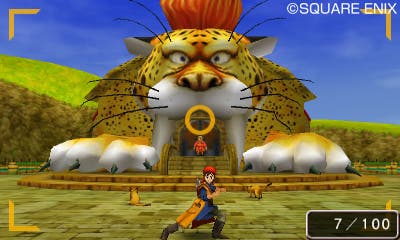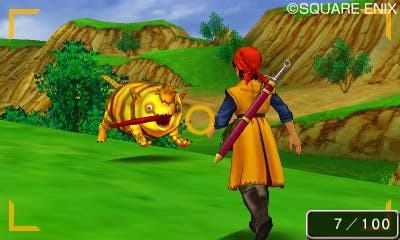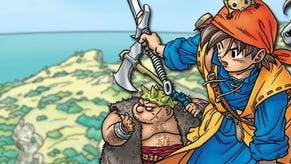Dragon Quest 8: Journey of the Cursed King 3DS review
Slime and the family trode.
A murderous jester has cast a spell turning the king into a frowsy troll and his daughter, the princess, into a pretty horse (those come-to-stable eyes!). As the king's retainer, you are charged with accompanying these misfit royals as they trundle around Trodea's bucolic hills and valleys in search of revenge or, at very least, a face-fixing antidote. En route you pick-up a talentless criminal after he fumbles a hold-up on a bridge; the spirited and estranged daughter of a noblewoman, who longs to avenge the death of her murdered brother; and, finally, a flop-fringed knight who is just as likely to try to flirt his way out of an altercation as to draw his rapier. Often Japanese RPGs are burdened with impenetrable, byzantine plots that leave all but the most determined player bewildered. It's a charge that bounces off Dragon Quest 8, whose Grimm-like story is told with clarity, sincerity and exquisite wit.
First released in 2004, Dragon Quest 8 was the first game in master storyteller Yuji Horii's series after the merger between rival Japanese RPG publishers Square and Enix. It certainly benefitted from the expanded workforce. This was one of the first 3D RPGs to place players in an open world, where you could pick out a point on a distant hill and walk there. In its day, it was a dazzling feat of engineering. Now, at the time of this Nintendo 3DS remake, it's a trick so common as to have lost all novelty. Nevertheless, the wonder and delight of Dragon Quest 8's world-design has been undiminished by time's passing. The colour and vibrancy of its cliff-top views and forest thickets, its cathedrals and lighthouses its ports and catacombs have been transported intact to the miniature screen (even if the cel-shaded effect of the PlayStation 2 version, which outlined every character and object in the world with a chic, thin black line is gone).

While there are no random battles - you can outrun most of the bobbing, imaginative monsters that roam the fields outside the game's towns and cities if you don't fancy a skirmish - this is a deeply traditional RPG in structure. The linear plot corresponds tightly to the flow of the geography. Narrative beats are delivered in sequence along Trodea's winding roads. When you stride out into the withering sunlight after a good night's sleep at a town inn, you can be sure that the next dollop of story will be served as soon as you reach the next settlement along the road. The adventurous can step off the beaten path in search of treasure chests and side-missions, but Dragon Quest 8's narrative spine is so strong and alluring that, most of the time, you'll be too eager to find out what's coming next to deviate for long (usefully, in this remake, you no longer have to find maps for every new area you come to; you have access to the world's full cartography, and each relevant map is displayed constantly on the bottom screen).
Battles follow the old-fashioned line-dancing format, where party members and monsters politely await their turn to whack one another into oblivion. On levelling up each character is given a clutch of skill points which can be invested in a range of specialities, unlocking relevant buffs and new moves. Upgrades must be carefully considered as this is far from an easy game. You must save your progress frequently in local churches while every boss battle must be carefully planned and executed.
While the mechanical aspects of Dragon Quest 8's design feel simplistic today, they remain graceful and frictionless, never getting in the way of the storytelling, the jewel of the project. Characters are wonderfully voiced, with a babble of accents including Scottish brogues and cockney drawls, each thoughtfully cast to emphasise class distinction and tension. Horii takes his time drawing the main cast together - it's around six hours till all four spots on the team are filled - and the backstory and motivations of each are filled in with careful pacing (aside, that is, from the bandana-wearing hero, who is largely left as a blank cipher). This is an ostensibly more childish game than, say, stablemate Final Fantasy. But despite appearances, its themes are often more nuanced and challenging. The game dabbles with grief and vengeance, women's rights and even the way in which the effects of adultery can victimise children caught up in its disorientating waves.

While Square Enix hasn't bothered to make use of the handheld's 3D effect, the team has invested time and energy in other, arguably more fruitful, areas. After clearing the first couple of dungeons you make a longer journey to a seaside resort known as Port Prospect. There you're greeted by a new character exclusive to this version of Dragon Quest 8: Cameron Obscura, a recently retired travel photographer. Obscura commissions you to take pictures while on your travels, a new feature for this version of the game, in order to allow him to live vicariously through your journey. While its possible to take pictures of anything in the game and to save those images to your memory card, Obscura issues you with a huge raft of challenges that provide focus and inspiration to seek out remote places and unusual monsters. You're richly rewarded for completing these missions, which not only require you to take photographs of monsters during specific idling animations, but also of particular landmarks, statues and pieces of architecture. In this way what could have been a throwaway gimmick is turned into a game-enriching core feature, one that encourages further exploration and interest.
The other 3DS additions are less crucial. You can now quick save your game anywhere, and trade postcards from your photo collection with other players whom you pass while out and about. Still, Dragon Quest 8 was never in particular need of embellishment. Its looks may have aged (and this 3DS version is undeniably less pretty than the original, with its plainer looks and diminished detail) but its treasures have not dulled. This is a joyous fairy-tale that, like the best fairy tales, transcends the fashions of the day.





